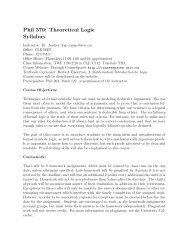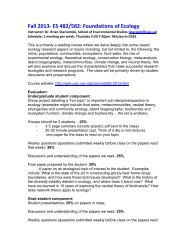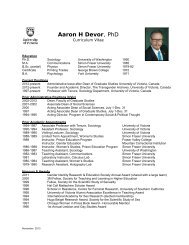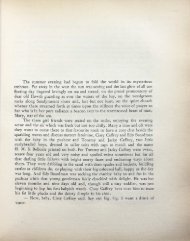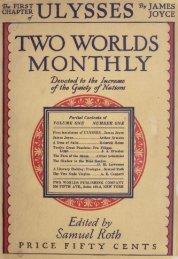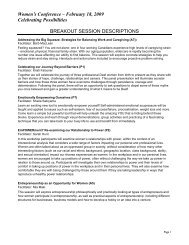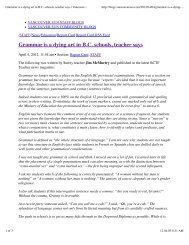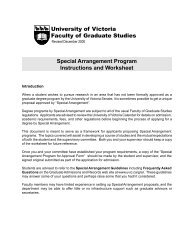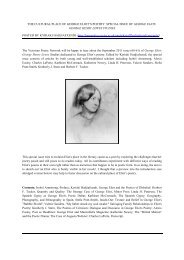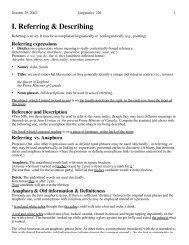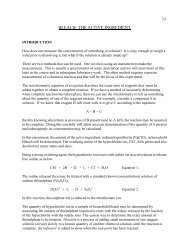"Architecture or Revolution": Taylorism, Technocracy, and Social ...
"Architecture or Revolution": Taylorism, Technocracy, and Social ...
"Architecture or Revolution": Taylorism, Technocracy, and Social ...
Create successful ePaper yourself
Turn your PDF publications into a flip-book with our unique Google optimized e-Paper software.
techniques, Le C<strong>or</strong>busier believed, could<br />
<strong>and</strong><br />
architecture be produced cheaply, <strong>and</strong> thus<br />
square-built <strong>and</strong> no longer a disan<br />
isolated discipline. In contrast to the<br />
mal<br />
become available to all.<br />
congeries; they will<br />
Beaux-Arts<br />
inc<strong>or</strong>p<strong>or</strong>ate<br />
practioners who rarely conthe<br />
This argument becomes one of the<br />
principle of mass-production <strong>and</strong><br />
sidered in the prewar period the issue of<br />
predominant<br />
themes in his famous<br />
large-scale industrialization.27 housing <strong>or</strong> new materials, Le C<strong>or</strong>busier<br />
polemic<br />
was arguing f<strong>or</strong> an expansion of the very<br />
Vers une architecture. As Reyner Banham This vision of the future models housing conception of the architect's role to emhas<br />
demonstrated, the text, composed production on airplane <strong>and</strong> automobile brace the consideration of social problems.<br />
largely of a series of articles published in manufacture. Just as Henry F<strong>or</strong>d's assem- Tayl<strong>or</strong>ism <strong>and</strong> new industrial methods were<br />
L'Esprit Nouveau, can be interpreted as a bly line was to result in lower-priced goods the only way the architect could continue<br />
dialectic between old <strong>and</strong> new, classical <strong>and</strong> m<strong>or</strong>e available commodities f<strong>or</strong> the to be relevant in a society threatened with<br />
<strong>and</strong> mechanical, architecture <strong>and</strong> engi- w<strong>or</strong>ker, so, too, industrialized building potential destruction.<br />
neering, which concludes that architecture processes were to reduce housing costs Le C<strong>or</strong>busier stated this with greater<br />
must inc<strong>or</strong>p<strong>or</strong>ate the lessons of mass pro- <strong>and</strong> provide a "maximum dwelling" f<strong>or</strong> zeal <strong>and</strong> to a larger lay audience than did<br />
duction <strong>or</strong> perish.25 Although its links with all. Even the relationship between tenant any of his French contemp<strong>or</strong>aries, but he<br />
the past are deep <strong>and</strong> explicit, the book <strong>and</strong> l<strong>and</strong>l<strong>or</strong>d was to be changed in the was hardly alone in his perception of housstrongly<br />
proclaims a commitment to an "inevitable social evolution." Lower costs ing as "the problem of the epoch" <strong>and</strong> "at<br />
industrial future. It is, in fact, in a passage would permit a system of rent purchase in the root of social unrest."32 With the exfollowing<br />
his nostalgic tribute to the Acrop- which tenants would take shares in the ception of the Communists, all sides of the<br />
olis that Le C<strong>or</strong>busier introduces his most enterprise.28 Similarly, a m<strong>or</strong>e efficient political spectrum-republican, socialist,<br />
significant <strong>and</strong> <strong>or</strong>iginal argument, "Mass- urbanism, including rational transp<strong>or</strong>tation clerical-were in acc<strong>or</strong>d. In Paris, about<br />
Production Houses". Here he specifically systems <strong>and</strong> an increased density of ser- two fifths of the population were said to be<br />
advocates Tayl<strong>or</strong>ism <strong>and</strong> modem industrial vices, would lead to greater economies dangerously housed; serious overcrowding<br />
methods, <strong>and</strong> at the same time illustrates <strong>and</strong> increased l<strong>and</strong> values. One need not <strong>and</strong> general deteri<strong>or</strong>ation of living condihis<br />
own studies f<strong>or</strong> low-cost prefabricated w<strong>or</strong>ry about sacrificing the rich to solve tions were common. Some 16,000 deaths,<br />
housing: Dom-ino, Monol, Citrohan, <strong>and</strong> the social problems of the po<strong>or</strong>. The sur- in the 1920s alone, were attributed to these<br />
the Immeuble-Villas.<br />
pluses, as Le C<strong>or</strong>busier was later to explain, conditions. The severity of the housing<br />
The section opens with the assertion that would be sufficiently large to compensate crisis threatened to drive traditionally stable<br />
Bonnevay <strong>and</strong> Loucheur's reconstruction the owners "up to the present value of middle-class supp<strong>or</strong>ters of the Third Replan<br />
f<strong>or</strong> 500,000 low-cost dwellings is an their property.' '29 Additional funds would public into a precarious financial position<br />
"exceptional event," <strong>and</strong> continues with still remain f<strong>or</strong> greater public services. Le as housing costs soared while income stagthe<br />
statement that the building industry is C<strong>or</strong>busier's "technical solution," like nated.33 It was not illogical to see these<br />
completely unequipped to meet such a Tayl<strong>or</strong>'s "mental revolution," offered an conditions as leading to social unrest. Like<br />
program.26 The only solution, Le C<strong>or</strong>bu- improved environment f<strong>or</strong> all.<br />
Le C<strong>or</strong>busier, Loucheur saw large-scale<br />
sier asserts, is the ab<strong>and</strong>onment of h<strong>and</strong>- The social urgency of implementation construction of low-cost housing as one of<br />
crafted production <strong>and</strong> the widespread becomes the focus of the last chapter of the only means of preserving the weak <strong>and</strong><br />
adoption of modem industrial techniques Vers une architecture, written specifically tottering Republic.34 N<strong>or</strong> were other archi-<br />
-technical specialists, w<strong>or</strong>kshops, stan- f<strong>or</strong> the book's publication. Le C<strong>or</strong>busier's tects completely unaware of the necessity<br />
dardization, mass production; the innova- analysis was based upon the assumption of coping with this immense problem. Long<br />
tions of war manufacturing must be applied that the physical environment-namely, bef<strong>or</strong>e the war ended, as Kenneth Silver<br />
to housing.<br />
housing-was the maj<strong>or</strong> social ill facing has shown, architects argued f<strong>or</strong> an ex-<br />
The war has shaken us all up. One<br />
France. "The balance of society comes p<strong>and</strong>ed conception of the profession's sotalked<br />
of Tayl<strong>or</strong>ism. It was done.<br />
down to a question of building."30 Both cial role.35 The architect Adolphe Dervaux,<br />
Contract<strong>or</strong>s have bought new<br />
w<strong>or</strong>kers <strong>and</strong> intellectuals (such<br />
plants<br />
appeals to f<strong>or</strong> instance, claimed:<br />
-ingenious, patient <strong>and</strong> rapid. Will<br />
a professional elite were common to both<br />
Now to create <strong>or</strong> reconstruct a<br />
the yard soon be a fact<strong>or</strong>y? There is<br />
Le C<strong>or</strong>busier <strong>and</strong> Tayl<strong>or</strong>ist advocates) sufcity,<br />
is<br />
talk of houses made in a mould<br />
fered<br />
by<br />
seriously from the lack of<br />
assuredly an issue of national<br />
appropriate<br />
pouring in liquid concrete from dwellings: tuberculosis, mental dem<strong>or</strong>aleconomy,<br />
but it's also architecture!<br />
To sanitize a<br />
above, completed in one day as<br />
ization, <strong>and</strong> the destruction of the<br />
tightly populated<br />
you<br />
family<br />
would fill a bottle<br />
were<br />
....<br />
among the dire consequences; social<br />
region, to join a river's banks with a<br />
upheaval was imminent in postwar France.<br />
bridge, that's architecture.<br />
To<br />
Nothing is ready, but everything can<br />
The book concludes with his famous rhetplan<br />
conveniently a locale, to<br />
be done. In the next<br />
<strong>or</strong>ical<br />
twenty years,<br />
plea f<strong>or</strong> ref<strong>or</strong>m:<br />
study the inhabitant's social customs<br />
<strong>and</strong> needs to ease their lab<strong>or</strong>, their<br />
big industry will have co-<strong>or</strong>dinated Society is filled with a violent de- education, their rest-that is, to<br />
its st<strong>and</strong>ardized materials, compara- sire f<strong>or</strong> something which it may ob- involve onself with individual <strong>and</strong><br />
ble with those of metallurgy; tech- tain <strong>or</strong> may not. Everything lies in collective psychology-that's still<br />
nical achievement will have carried that: everything depends on the eff<strong>or</strong>t architecture.36<br />
heating <strong>and</strong> lighting <strong>and</strong> methods of made <strong>and</strong> the attention paid to these<br />
And the<br />
rational construction far beyond anylarge<br />
exhibition La Cite Reconstialarming<br />
symptoms.<br />
thing we are acquainted with. Con- <strong>Architecture</strong> <strong>or</strong> Revolution.<br />
tuee, held in the Tuileries gardens in 1916<br />
<strong>and</strong><br />
tract<strong>or</strong>s' yards will no longer be Revolution can be avoided.3'<br />
<strong>or</strong>ganized by such prominent practitioners<br />
as<br />
sp<strong>or</strong>adic dumps in which<br />
Agache, Jaussely, Jourdain, <strong>and</strong><br />
everything<br />
breathes confusion; financial <strong>and</strong><br />
This statement of strong protest was still Plumet, focused on the problem of resocial<br />
<strong>or</strong>ganization, using concerted<br />
far less radical than the conclusions of the construction <strong>and</strong> the use of new industrial<br />
<strong>and</strong> f<strong>or</strong>ceful methods, will be able to growing Communist Party. But although building methods "to spread the fruitful<br />
solve the housing question <strong>and</strong> the<br />
Vers une architecture was a call f<strong>or</strong> ref<strong>or</strong>m principles of association, cooperation, reyards<br />
will be on a huge scale, run <strong>and</strong><br />
not violent revolution, f<strong>or</strong> w<strong>or</strong>king within grouping, which will conspicuously faciliexploited<br />
like government offices. existing political <strong>and</strong> economic structures tate the realization of plans of developrather<br />
than<br />
Dwellings . . . will be en<strong>or</strong>mous<br />
overthrowing them, it was ment ..<br />
37<br />
hardly a retrenchment into architecture as Although culturally, conservative fac-<br />
136 ArtJournal



